By Ken Donald, Patron of CESRT as told to Jan OConnor
The conditions looked great for a quick fish, back in the summer of 1974. On Thursday the 21st of February, two Pungarehu men had a day off from the factory and launched their small cabin cruiser from Cape Egmont early in the morning. All went well for Murray Johnston and Mervyn Lowry until they went to start the boat about an hour later. An electrical fault had developed in the battery and the engine wouldn’t start. Back in those days it was common for recreational fishing vessels to not carry a VHF radio or even a CB radio.
Then the wind picked up to a strong sou’easter and the changeable seas off the Cape quickly turned rough.
The lads threw the anchor over the side to stop themselves drifting, but it wouldn’t hold. The boat was now at the mercy of the elements. A couple of hours later, to make matters worse, the waves were now breaking over the sides. The two friends started bailing, hoping like hell that someone was coming to get them...
Part of the Cape Egmont Boat Club’s function was to act as a base for maritime searches, and provide experienced locals to help the police. Local Police Search Adviser and boat club member Ken Donald got a call from the police at about 2pm.
“We had a system of the police called me, I called the next guy, he called the next guy and so on. We got the team together fairly quickly.”
The searchers gathered at the club rooms and Ken had the difficult task of working out how far the men had gone and in what direction, taking in to account the size of the boat, the sea conditions, wind direction and strength.
“I estimated the fishermen were now a fair way out, about 20km. The Aeroclub from New Plymouth got up and had a look. They started a search pattern and looked for a couple of hours but it was pretty rough at sea and plenty of white water and they couldn’t see a thing. By this time it was getting dark and the planes were was stood down.”
Ken was now starting to feel the strain.
“By about 6pm there were plenty of people around and the wives of the two men were in floods of tears, convinced their husbands would never be found. Then the church minister arrived to offer words of comfort, which had the opposite effect on me! The pressure was really growing to find these guys.”
In those days there was no telephone at the boat club. Ken sent a runner up the road to a local farmhouse to tell the police to get the Orion down. The crew took a few hours to get the plane ready and fly down from Auckland, so it arrived at 9pm. It immediately started a radar search pattern, and let off massive illuminating flares which were visible from shore. Still no luck. Then Ken had a feeling to ask the Orion to search bit closer.
The Orion confirmed they’d found the missing pair at 11.15pm, about 10 miles off Puniho in heavy seas. The fishing vessel Annabella was also out looking for them, and steamed over to pick Murray and Mervyn up.
The two friends arrived back at Port Taranaki at 3.10am to an emotional welcome from around 100 friends and family. They were sunburned and exhausted, but alive.
It turned out they had let off a couple of flares just before it got dark when the search plane flew overhead, but it didn’t see them. They then managed to start the engine and motored in for half an hour, before the engine cut out again.
“That was the important thing,” Ken said, “as it got them in from the deep.”
The engine had stopped again, this time for good. Murray and Mervyn began to wonder if they would ever make land. By the time the great sound of the Orion came overhead, they’d been bailing solidly for 8 hours.
It was too rough for the Annabella to tow the little cabin cruiser home, so it was left at anchor off Puniho. They hoped to recover it the next day.
“It went down in the night.” says Ken. “The boat was never seen again, and the boys would have gone down with it if they hadn’t have been found.”
From the newspapers: The two men set out at 6.30am, intending to be back in time for an important meeting in Stratford at 2.30pm. When they didn’t return, police were called and a plane was immediately sent up. The wind was a sharp 35 knots by now. Three light planes in total searched at sea from Bayly Road to Stony River until dark with no luck. A white boat was impossible to see in all the white water. The pencil flares that Lowry and Johnson had on board gave off a very small and quick light, and went unseen. Pencil flares are not in use today for this reason. Scores of men combed the coastline around Cape Egmont in search of the missing boat and were stood down as night fell.
Two fishing boats equipped with radar were also searching, but with no luck. A recreational fishing boat had launched from the Cape Egmont Boat Club during the afternoon to find the pair, but had to turn back when high seas swamped the radio onboard.
Large crowds had gathered at Bayly Road by now but were unable to do anything but watch for flares and listen to radio updates.
The Orion sighted them at 11.15pm and by 3.10am the pair disembarked at Port Taranaki from the FV Annabella.

